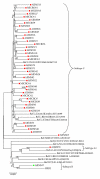Prevalence of HIV Drug Resistance Mutations in HIV Type 1 Isolates in Antiretroviral Therapy Naïve Population from Northern India
- PMID: 22496972
- PMCID: PMC3312221
- DOI: 10.1155/2012/905823
Prevalence of HIV Drug Resistance Mutations in HIV Type 1 Isolates in Antiretroviral Therapy Naïve Population from Northern India
Abstract
Objective. The increased use of antiretroviral therapy (ART) has reduced the morbidity and mortality associated with HIV, adversely leading to the emergence of HIV drug resistance (HIVDR). In this study we aim to evaluate the prevalence of HIVDR mutations in ART-naive HIV-1 infected patients from northern India. Design. Analysis was performed using Viroseq genotyping system based on sequencing of entire protease and two-thirds of the Reverse Transcriptase (RT) region of pol gene. Results. Seventy three chronic HIV-1 infected ART naïve patients eligible for first line ART were enrolled from April 2006 to August 2008. In 68 patients DNA was successfully amplified and sequencing was done. 97% of HIV-1 strains belonged to subtype C, and one each to subtype A1 and subtype B. The overall prevalence of primary DRMs was 2.9% [2/68, 95% confidence interval (CI), 0.3%-10.2%]. One patient had a major RT mutation M184V, known to confer resistance to lamivudine, and another had a major protease inhibitor (PI) mutation D30N that imparts resistance to nelfinavir. Conclusion. Our study shows that primary HIVDR mutations have a prevalence of 2.9% among ART-naive chronic HIV-1 infected individuals.
Figures
References
-
- NACO. Annual report 2009-2010. 2010. http://www.nacoonline.org/NACO.
-
- UNAIDS. 2010 Report on the Global HIV/AIDS Epidemic. 2010. http://www.unaids.org/globalreport/documents/20101123_GlobalReport_full_....
-
- Little SJ, Holte S, Routy JP, et al. Antiretroviral-drug resistance among patients recently infected with HIV. The New England Journal of Medicine. 2002;347(6):385–394. - PubMed
-
- Grant RM, Hecht FM, Warmerdam M, et al. Time trends in primary HIV-1 drug resistance among recently infected persons. Journal of the American Medical Association. 2002;288(2):181–188. - PubMed
-
- Masquelier B, Bhaskaran K, Pillay D, et al. Prevalence of transmitted HIV-1 drug resistance and the role of resistance algorithms: data from seroconverters in the CASCADE collaboration from 1987 to 2003. Journal of Acquired Immune Deficiency Syndromes. 2005;40(5):505–511. - PubMed
LinkOut - more resources
Full Text Sources
Molecular Biology Databases
Research Materials
Miscellaneous


